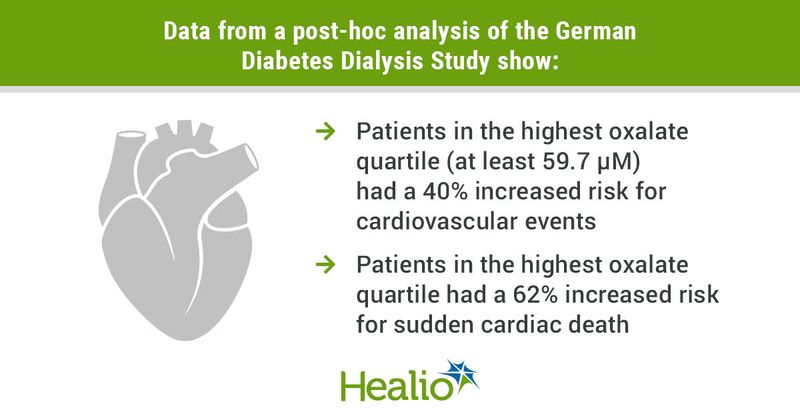High oxalate levels raised risk for sudden cardiac death by 62% in patients on dialysis
Elevated concentrations of serum oxalate were associated with an increased risk for cardiovascular mortality, most notably from sudden cardiac death, according to a post-hoc analysis of the German Diabetes Dialysis Study.
The analysis included 1,108 European patients with diabetes who were on maintenance hemodialysis, with researchers validating the findings in a separate cohort of 104 patients receiving dialysis in the United States.

“In a well-established cohort of dialysis-dependent patients with kidney failure, we found that high serum oxalate concentrations were associated with an increased risk of experiencing a cardiovascular event and dying of sudden cardiac death,” Anja Pfau, MD, of the department of nephrology and medical intensive care at Charité Universitätsmedizin Berlin, and colleagues wrote. “These associations were robust after adjustment for a comprehensive panel of covariates, including treatment with statins as the interventional measure in the 4D Study, and accounting for competing risks in a sensitivity analysis.”
For the analysis, Pfau and colleagues considered the associations between oxalate concentrations and sudden cardiac death, death due to congestive heart failure, fatal myocardial infarction, or death due to coronary disease.
The European cohort was followed for a median of 4 years, during which 548 patients died (25.4% from sudden cardiac death) and 413 patients reached the primary composite cardiovascular endpoint (consisting of cardiac death, nonfatal myocardial infarction and fatal or nonfatal stroke).
Researchers determined median oxalate concentration to be 42.4 µM, with patients in the highest oxalate quartile (defined as at least 59.7 µM) having a 40% increased risk for cardiovascular events (adjusted hazard ratio = 1.40) and a 62% increased risk for sudden cardiac death (aHR = 1.62) compared with those in the lowest quartile.
Further, the risk of sudden cardiac death increased “incrementally and significantly with higher oxalate concentrations.”
Higher baseline oxalate concentrations also demonstrated associations with an incrementally higher risk of mortality due to congestive heart failure and patients in the highest oxalate quartile had more than a two times increased risk for death due to this cause compared with patients in the lowest quartile (aHR = 2.40).
“Randomized prospective interventional trials are necessary to determine if active reduction of oxalate levels efficiently lowers the risk for sudden cardiac death and other cardiovascular events in dialysis patients,” Pfau and colleagues wrote. “Two common parameters of nutritional status, creatinine and albumin, were positively correlated with higher oxalate concentrations in the 4D cohort. This may point to novel strategies including avoidance of foods high in oxalate content to lower serum oxalate concentration and cardiovascular mortality in dialysis patients. Further potential treatment options might involve new pharmacological advances as administration of orally available oxalate decarboxylase enzyme, and even silencing RNA technology to reduce liver production of oxalate.”
